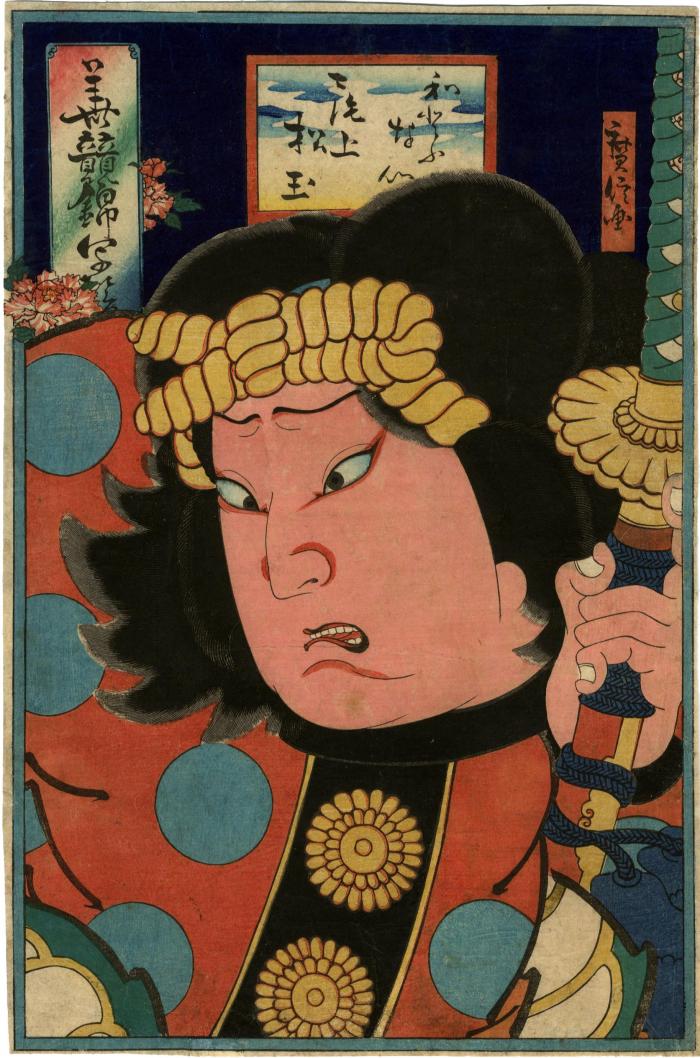Kinoshita Hironobu I (初代木下広信) (artist )
A kabuki actor as Watōnai (和藤内)
1865
9.125 in x 13.625 in (Overall dimensions) Japanese woodblock print
Signed: Hironobu ga (広信画)
Harvard Art Museums
Rijkmuseum - Yoshitaki print with the same series title and from the same date Only one source on the internet has identified this actor as Onoe Shōgyoku, an actor we have been unable to find so far anywhere else. The figure of Watōnai is wearing a headband made up of an anchor rope or ikarizuna (碇綱). Often this character is dressed in a robe decorated with an ikarizuna pattern.
Possibly from the rare set: "A Comparison of Various Pictures". The first edition was deluxe with tons of metallic inking. Waseda University identifies another print from this series as being from Hana kurabe nishiki no utsushi-e (華競錦写絵). The Japan Arts Council says this dates from the 5/1865.
****
We have added an image of Watōnai by Sadanobu from ca. 1847-48. (See the attached image.) Osaka Prints wrote of this print:
"The play Kokusenya kassen (Battles of Kokusenya: 国性爺合戦), written by Japan's great Edo-period playwright Chikamatsu Monzaemon (1653-1724), has long been considered a masterpiece of Bunraku (puppet theater 文楽). First staged in 1715 at the Takemoto no Shibai, Osaka, it remains unsurpassed as the most successful play in the history of the puppet theater. Kabuki also produced many adaptations, starting in 1716 at the Miyako Mandayû Theater in Kyoto."
"The hero Watônai Sankan, a fisherman by trade, was also the son of Ikkan, a former Ming minister named Tei Shiryû who had been exiled to Japan. Trained in military strategy, Watônai travels to China to aid a princess named Sendan, the younger sister of the Chinese emperor murdered by the Tartars. Watônai vows to fulfill his father's promise to restore the Ming dynasty and place Sendan on the throne. He and Ikkan travel to China, where they find Ikkan's daughter and Watônai's half-sister, Kinshôjô, married to a general named Kanki, of Ming ancestry but allied with the Tartars. In the most celebrated scene of the play, the so-called beni nagashi shishigajô ("the red signal inside the castle"), Kinshôjô, who is loyal to her father and Watônai, agrees to ask Kanki to join Watônai. However, she has them wait outside the Lion Castle for a sign of her husband's intentions: a powder — white for "yes" and red for "no" — to be tossed into cascading water flowing down to the castle moat. Kanki is sympathetic to her request but cannot take advice from a woman on military matters, as it would bring shame upon himself and his descendents. He is also bound by a promise he has made to the Tartars to kill Watônai. Always the warrior, Kanki considers murdering his wife to quell any rumors of his being a coward, but is dissuaded by Kinshôjô's stepmother (Watônai's Japanese mother, who was allowed to enter the castle to plead their cause). Upon seeing the "red signal," Watônai bursts into the Lion Castle to confront Kanki, but the two quickly become allies and Watônai is given the name Kokusenya, Lord of Enpei."
actor prints (yakusha-e - 役者絵) (genre)
Kyōto-Osaka prints (kamigata-e - 上方絵) (genre)
Battle of Coxinga (Kokusenya Kassen - 国性爺合戦) (genre)
Chikamatsu Monzaemon (近松門左衛門) (author)
